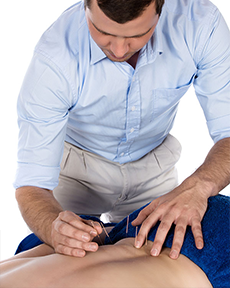I still have to meet the one person who hasn’t experienced a bout of lower back pain. Your low back pain is caused by an injury to any of the lumbar tissues like muscle, nerves, tendons, discs, joints & bone. Irritation, damage or injury to these structures may start with slight discomfort but quickly gets worse to cause severe pain. This is a problem we see at our practice daily. It’s a tricky process to accurately identify the original cause of your problem. Muscles spams – but it could be guarding a deeper problem, nerves gets pinched – but what’s pressing on the nerve, and joints get inflamed but why only that joint. These are the questions our medical professionals go through to analyze your lower back pain in order to diagnose the cause, then we’ll guide you though the best proven treatment program that speeds up your recovery.
Accurate diagnosis of the underlying cause of your lower back pain is the first step in getting effective pain relief. Without an accurate diagnosis, the treatment becomes ineffective, wasting your time and money. Above all, being treated without a diagnosis is a recipe for failure. You need a trained eye to test all the structures in and around your lower back to determine the extent of the damage.
What causes my lower back pain?
To understand where your lower back pain is coming from, you’d have to determine how you injured it, or if you can remember when it started. Some are outright obvious like picking up a heavy object, meanwhile others are subtle and creeps up on you – getting worse day by day. So, it’s easier to establish how your pain started and changed until now. Changes in your lower back pain gives us many clues to understand where your pain is coming from.
Your lower back consists of various types of tissue, apart from the bones, muscles can spams up, nerves can get pinched, discs can slip out. So, when the structures that should support your back and doesn’t do its job your spine becomes unstable. This leads to excessive forces on certain structures causing them to give in under the large amounts of pressure. To understand these structures and why they are not supporting the back as they should, we must look at each component separately as part of the whole.
The structures in your lower back is quite vulnerable to injury, especially overuse injuries. There are more than 89 structures in your lower back that can get injured, some problems are more common than others, but just to be safe – we test them all.
Here’s a breakdown of a few conditions that we frequently see, and how things go wrong to cause your lower back pain:
Get to the root of your lower back pain
Different structures, cause different types of lower back pain, although these are not concrete it’s a good guideline to which structure produces what type of pain
- Muscle — Dull ache or stiffness, sharp pain with movement, better at rest.
- Nerve — Numbness, tingling, weakness, electrical stabbing feeling, weakness in the legs.
- Tendon — Nagging, Burning pain with specific movements, pain comes & goes.
- Joints — Cramp, constant stiff feeling, worse after rest, better with movement.
- Disc — Pinching pain, bending forward increases pain immediately.
- Bursa — Pain only comes on after being active, better with rest.
- Bone — Constant pain, sharp pain with certain movements.
- Arteries — Pins & Needles, dead leg feeling, heavy feeling.
- Cartilage — Sharp pain when straightening your lower back, painful arch of movement.
- Ligament — Pain at the end of range, unstable, clicking.
- Referral from other joints — Difficult to pinpoint pain, vague painful area that moves.
- Vertebrae — No comfortable position
Symptoms of Lower back pain
Concerned about your lower back?
Maybe you should be…
How bad is my lower back pain?
Size – The larger the area of your lower back pain, the worse it gets, muscles tend to radiate pain faster like a band across your lower back and hips. Luckily muscles heal fast & completely recover.
Swelling – It’s rarely visible, but in a tight space, the smallest amount of swelling easily starts pressing on nerves causing a cascade of lower back pains. So if you can’t see it, it doesn’t mean its not there. Injury to tissue that develops over a few weeks doesn’t swell, because the tissue trauma is continuous and repetitive, so your body stops the inflammatory reaction. A new injury on an old problem is also possible.
Area – Lower back pain that’s dead center in small area is fast to expand into the a larger area within days. Sharp pain over a small area makes it easier to pinpoint structures near your lower back pain. Vague, dull & deep lower back pain can take longer to identify the root cause. Compensatory patterns develop, sometimes it takes a while to just get rid of those before we unravel the underlying cause.
Motion & sore Lower back
Stiff – Lower back stiffness followed by pain is regressing and getting worse. Seek help. Pain followed by stiffness is a good sign of tissue healing, specifically scar tissue formation. Scar tissue is hardening wound tissue that tends to shorten and pull on structures surrounding the injured site. This is more pronounced in muscle strains & tears, where the normal slide of muscles is restricted during a contraction.
Range of movement – Difficult moving your lower back through its range is a big problem. A painful arch means the structure injured only takes tension over that specific range i.e Only painful when you bend forward, and still able to touch your shin. The more movement is restricted, the more severe your problem. If you feel pain only at the end of your range its less severe and easy to fix. When your lower back pain stops movement completely and too painful to move you should definitely come see us as soon as possible.
Monitor over time:
Intensity – When you grade your pain from 0 – 10. You may think it’s not that bad because it’s not that painful. On the contrary, pain intensity is not a reliable sign of how severe your tissue injury is. People have different pain thresholds, so be careful to ignore your lower back pain for too long.
Frequency – Pain that’s fleeting or intermittent, short burst of pain must not become more frequent and constant. This shows that the tissue damage is not getting any better. Lower back pain that only lasts for a few seconds tend to heal faster, so the longer your pain lasts the faster you should get to us.
Latency – If your pain lags to come on and builds up over the day you must be very cautious. This is a sign of a relapse of your tissue pathology. It’s difficult to judge what makes it worse, because the pain only comes on a few hours after your activity, and not during. Usually flaring up at night, and you just want to lay down. Rest is not going to get you recovered. How about you do something about it.
Loading – Pushing through your lower back pain while you are walking, climbing stairs and jogging is not a good idea. Putting compromised tissue under strain is dangerous. Would you tow a car with a partially torn cable? No! Because it just needs that final pull or jerk that could cause catastrophic tissue damage. Loading soft tissue without knowing what it’s able to handle is dangerous & reckless.
Diagnosis of Lower back pain
Our physiotherapists know and understand the intricacy of the anatomy of your lower back & spine. There are many structures to test, and we even consider the complex biomechanics of your spine and hips. We’ll accurately diagnose which structures are involved, and to what degree.
During your evaluation, we’ll be stretching & stressing the soft tissue structures like muscles, ligaments, nerves, discs and tendons. This way we can diagnose muscle tears, ligament sprains, slipped discs and nerve irritations. We’ll test different aspects like muscle strength, range of motion, flexibility and stability in order to confirm how severe your tissue damage is, which will dictate your treatment plan.
Gathering information through our evaluation allows us to make a diagnosis based on your individual injury. Then we’ll customize the treatment to your specific needs. Therefore our physiotherapists are the best at diagnosing lower back pain.
The Process of Diagnosis:
There is a misconception that medical practitioners are able to know exactly that’s the problem the moment we see our patients. People tend to point to their back and say, “treat it”. As if we already know what’s the problem by just looking at it. Sorry to disappoint, but unfortunately this is not how it works. Let me explain:
Diagnosis is a process of exclusion, not inclusion. Medical professionals are taught a process of elimination and deduction to identify the most possible diagnoses for your lower back pain. The better you can describe & elaborate on your pain, the better picture you’ll give your Physio to understand what’s happened as well as, what you’re feeling.
The practitioner uses their skills to eliminate diagnosis’s it’s not and zoom in on your problem. We perform tests on numerous structures to get even more clarity. This elimination brings us to only a few possibilities to what could be causing your lower back pain. Then we test & assess all our possibilities to get to the root cause. In many cases your main problem is not at the site of your lower back pain due to compensation or guarding.
Misconceptions regarding lower back pain
Back pain usually starts as stiffness before you experience pain. That feeling of something is about to go wrong. It’s inevitable that if you do not change the way you use your back and identify the problem, it will result in injury. However, there is the possibility of it relieving by itself. Also if you feel no pain, we assume it has healed, but I would like to warn you about how the body can start to compensate.
Your body has an amazing ability to repair itself and can provide temporary relief from an acute episode of back pain. Unfortunately, overcompensation offers only short term relief. Due to this compensation, 62% of those with pain will come back in the next 12 months. The problem is the back pain never goes away; you stop doing certain activities. In short, you learn to live with it rather than work to rid it.
How can we help?
We identify these pattern during an assessment and prevent a perpetual cycle. We can stop these episodes or flare-ups from becoming longer and longer. Treatment prevents the pain from returning faster and more severe with each episode. Your body is extraordinary in its ability to heal and restore itself, up to a point. At a certain stage, adequately repair is impossible due to the amount of misuse and abuse. After a while, you start to feel the pain again. This pattern then repeats endlessly, and most people will tell me that they have had back pain for several years. After that, they give up on doing rehabilitation because it seems to be part of their lives.
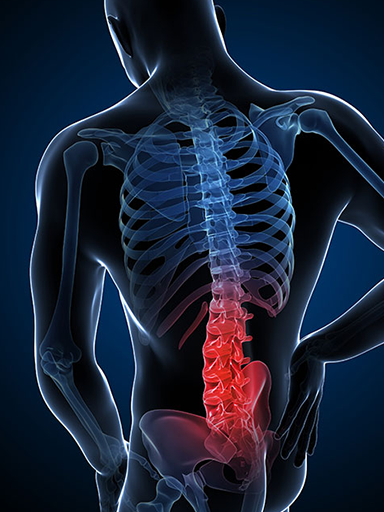
Physiotherapist treatment
Your body is a interconnected machine that has different structures, performing various jobs thus it’s critical to identify the structure at fault before we start with treatment. We have seen many patients with lower back pain and provide the best possible treatment for a faster recovery. Pain and stiffness prevents you to move and you might feel hesitant to move, or scared you’ll damage it even more. We know that you’re anxious about the unknown, so that is why we are here to guide you and give you all the answers.
Your lower back pain treatment will be tailored according to various factors, but just to give you a broad idea, our focus of our treatments are. Firstly to establish which structures are injured in your lower back, and how bad is it. This puts the scope of the problem into full perspective. Usually there’s a knock on effect, where a few structures are involved, but we must determine what’s the order of priority.
Secondly, we must protect your lower back from further injury and stop it form getting worse. Thirdly, we set the ideal conditions for tissue to recover. Now we can even accelerate and speed up your recovery and get tissue healing. The last aspect of our process is monitoring your progress as you progress, making sure you achieve the goals and milestones. Our treatment program changes as you adapt and get better.
We explain the extent of damage & the intricate details of your lower back pain & how it may cause other problems. Sometimes a spasm is just a muscle problem, but when the spasm is a guarding mechanism to protect a deeper structure, we know how to approach it.
Well Health Pro
Our team of experts can diagnose, test and treat any kind of lower back pain. We work together to get rid of your pain as fast as possible. We have the best tools, techniques and machines to make sure you get the best value for your money. Our Physios will test a lot of different possibilities why you’re feeling this lower back pain in order to explain what’s going on in your body. It all depends on the results of our tests to determine what needs to be done. All our physios are specialists that can determine the slightest problem coming from your middle, lower back or hips, so if you’re uncertain – we can help you.
Our experts determine the priority which problems to fix first. This means that we test movements to see if you may have a muscle imbalance, weakness, instability and much, much more. This is our expertise & what we’re best at. We’ll guide you every step of the way.
Not Diagnosed yet?
We have heard so many stories about patients getting advice from family members, friends, or following an exercise program on the internet. These patients tend to get frustrated because in most cases, they feel that “nothing seems to help“. They give up before they’ve even started the process. You would not take smarties and expect it to cure a cold. In the same way you cannot expect unspecific treatment to improve your condition.
Why doesn’t my medication work?
How can treatment or advice be given without knowing what the exact problem is?
This is why two people, both with lower back pain, can take the same medication, and one can improve, and the other doesn’t. The one’s problem is directly related to the structures that the medicine acts upon. If the medication is designed to work on the muscles, for example, a muscle relaxant then the first person’s pain were mainly muscular, his pain would improve. However, if the second person takes the same medication, but they have a joint problem, it will have no or little effect on his pain.
The above mentioned scenario explains why different movements, exercises, techniques, medication, and any form of treatment must be guided by the effect on the structure at fault, and not just a shot in the dark. Myths such as ‘it will always be weak’, ‘it’s hard to fix’, ‘it won’t get better’, ‘there is nothing that can be done’ — is not true. We specialize in difficult cases and have had great success with these “hopeless cases”.
“Walk it off” or it just needs some rest. Bad idea.
The biggest problem we as face are that people wait too long! It is disheartening when we see a patient that initially had a minor issue, but only consults us months later. The problems have escalated and evolved into a complex series of lower back problems.
A good example starts with lower back muscle stiffness with no current pain. The muscular tightness results in joint compression as the muscles press the vertebrae together. Furthermore, the disc (shock absorber) gets squashed and starts to degenerate. Then this compression entraps the nerves that run down the legs. Now you are sitting with excruciating sharp electrical pains that shoot down your leg. The pain is so severe you barely want to move.
Instead of just treating the muscle stiffness, now we have a long process of undoing all the other problems. The issue now has a joint, nerve and disc component. Early treatment is faster and more cost-effective. Treatment started within the first three days from your lower back pain starting is the ideal.
Even if you suspect it’s a small problem. Please don’t ignore it. Ask a medical professional and be safe.
The longer you wait, the more damage you cause. The longer it will take us to fix the problem.
Recovery time is linked to how long you’ve had the pain.
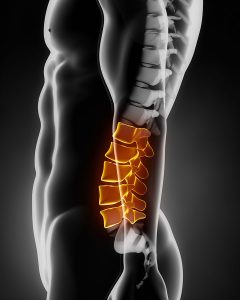
When do you need scans for lower back pain treatment
We can extensively test the lower back muscles, ligaments and joints without any scans. Physiotherapists use a variety of stress, pressure, movement, slide and glide tests. The tests identify the specific site or tissues where the problems are. In some cases where there is direct trauma (car accident, fall) we might approach it more carefully. We will refer you for lower back X-rays if necessary.
Identify the structure
It should make sense first to identify the lower back structure at fault before we send you for expensive scans and tests. Remember that not all scans show the same structures. X-rays only show the bones, a sonar or ultrasound shows the ligaments and muscle tissue on the surface. CT scan/ CAT scan shows more connective tissue than a sonar, but less than an MRI. MRI is the most detailed scan available, and shows up discs, bone cracks, stress fractures, nerves, and arteries. It comes with a expensive price tag.
There is no use getting an x-ray done of your lower back if you have a muscle or ligament problem. So we advise patients to start the process with us. We’ll even tell you what we’re expecting to see on the report. Our practitioners investigate the relationships between the structures in your lower back before you go spending thousands of Rands on unnecessary scans and tests.
Comfortable sleeping positions
- Sleep on your side with a pillow in between your knees to limit rotation of your back
- Sleep on your back with a pillow under your knees
One of the most important things that can contribute to low back pain is your mattress. Ensure you have a good quality mattress that supports your back so that you don’t wake up stiff or sore. When you go shopping for a new mattress it’s a good idea to go when your back is a little stiff or sore, so you can see which mattress supports you best.
Prevent lower back injuries:
It’s common to re-injure your lower back, and there are ways to protect your spine with exercise and correct lifting techniques. With lifting, make sure you bend your knees, keep your back straight, and the load close to your body. This includes when lifting or carrying children. Avoid twisting your back and always move your feet to turn. If you have a desk job, make sure you have a chair with a supported back or lumbar roll, and every half an hour to get up from your desk and stretch your back.
Imagine your back’s like a suspension bridge which is held together by cables and pulleys (the muscles and ligaments). One of the main muscular supports is the Multifidus muscles and the Transverse Abdominis (TA) muscle. These muscles act like scaffolding or support struts to hold the lower back in place, while the other muscles move your back into different directions. Importantly, when these muscles don’t activate like they should the whole lumbar spine becomes vulnerable and moves beyond its normal limits. This excessive movement can cause increased wear and tear on the joints or discs.
Fascia
Fascia is a dense connective tissue that reacts to the forces acting on it. These connective tissues are like a spiderweb that connects EVERYTHING in your body. So these fascial strands can cause restrictions due to excessive movement into a specific direction. This, in turn, restricts the normal movement of the joints in the back and that leads to other problems. In addition, the opposite direction can then also have too little tension.
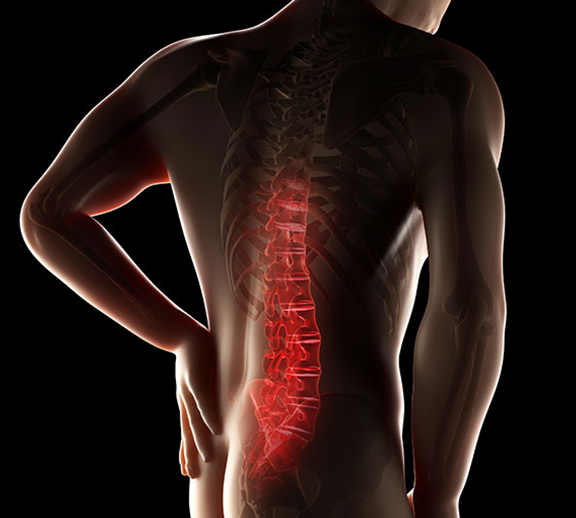
Lower back joints
Facet joints are the connections between two vertebrae and looks like people holding hands. The palms of the hand represent the two joint surfaces that can glide, slide and move on top of each other. In some cases, these joint become compacted due to stiffness in the back or more commonly from increased constant pressure. This constant pressure occurs when people sit for a long period (2-3 hours) without getting up. That is to say that sustained positions can place undue strain on the joints of the back.
You can imagine the pressure of your upper-body resting on a few small joints in your back for hours on end. Compare this to how long you are able to stand on your feet before you start getting restless. Naturally, you want to sit down in order to relieve the pressure off your feet. For example occupations like Lawyers, Auditors, Accountants, Programmers typically sit around 9 – 12 hours a day. Also in the same vein, occupations where you bend over forward causes similar issues.
How to Stop chronic, daily annoying Lower Back pain
Without injections, Without taking painkillers
No risking surgery
WITHOUT having to to wait to see the GP!
If you’ve got lower back pain, stiffness or an ache, it’s very tempting to think that it’s nothing and therefore that it will go away on its own. Or, you pass it off as having just “slept awkwardly”, or that it’s just a “spasm” or a bit of stiffness that “everyone” your age suffers.
There’s no apparent reason why it happened, but it doesn’t seem to be getting any better. If that’s happening to you, you’re not alone. We hear these words daily. In fact, lower back pain is the most common problem that we see in our physio practice. When it comes to living with lower back pain, everybody we see wants to know the following:
Why am I still suffering with lower back pain that keeps getting worse
Most people think that when they get lower back pain, it’ll eventually “ease off” and go away on it’s own. That they’ll wake up one morning and like “magic”, your lower back pain will be a thing of the past… But 3 months later you’re still living with the annoying lower back pain, often even worse than it was at the start. Does that sound like you?
Another scenario we see all the time in our practice is when people go to their Doctors, and the well-meaning Doctor tells them to “rest”, “try these painkillers” and “come back in 6 weeks if it’s no better” – but then 6 weeks later, they end up going back to the same Doctor again because it hasn’t got any better, only to be given another prescription of even stronger pills, and maybe a lower back brace.
Has this ever happened to you?
Why else does lower back pain last longer than it should? Well, it’s easy to get confused because you’ve been told different things, by different people. There are lots of people out there who are happy to dispense advice – but not all of it is credible. As a result, it’s difficult to find a workable solution.
Maybe you think your back pain was caused by doing something – like lifting or sleeping awkwardly – but it was caused by years and years of poor posture that caused the muscles in your lower back to become weak and the lifting and awkward sleeping position was just the EFFECT of that.
If you don’t know what you’re doing – lower back back pain can be very confusing. Many people just end up accepting it as ‘part of life’, thinking as if it’s normal and ‘just the way it is’. We’re here to tell you this is not what you deserve. Our practitioners gives you an accurate diagnosis and sound advice.
Why is your lower back pain lasting longer than it should?
Does this sound like you?
If any of these have happened to you – we would love to help you. The fact that you’ve tried any or all of these things already is actually a good thing, because when you know what doesn’t work – you are closer to finding the thing that does!
We invite you to come and see us. Why? Because we do things differently. We’ll do a thorough assessment and test all the possible causes. After we’ve diagnosed your problem, and explained what it’s going to need to heal, we’ll make sure you understand why this is happening.
If you’re looking for solid advice on how to start solving your problem, click the link below to book a FREE phone call. The phone call is complimentary and there is no obligation to book any appointments with us after the call is over. This is an opportunity to get an expert’s advice about your situation. Our goal is to help you make the right decision about what to do next.
What you can do to get rid of your lower back pain quickly?
Ask our Lower back pain experts
If you would like to know how our practitioners can help you, we invite you to book a FREE, no-obligation, risk-free “Call me back” phone call.
Note: This Free Call is a service we offer to people who are nervous or unsure. You might not know if Physiotherapy is the right treatment for you. If you are unsure, please fill out our online form. We will contact you to find out what is wrong and how we can help. There is no financial obligation or risk on your part. You have nothing to lose except your pain.
Choose to see a Well Health Pro Physiotherapist to help you Get rid of your lower back pain – in the next few days?
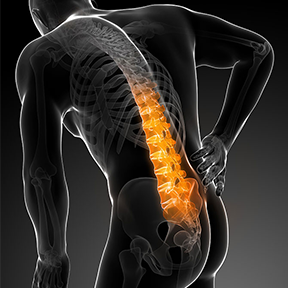
What your patients say:
I’ve been battling with lower back pain for years. I’ve spent weeks at the practice and it’s been a revelation. All the things I thought I couldn’t do, I’ve started getting back into it. Thank you so much.
S Schurr
I had severe back pain radiating down my back into my legs and could hardly stand up, I’m so grateful for these angels.
A Bouwman
Booked for surgery, just wanted some form of relief. Eventually 3 months later, my back was fixed! Cancelled the surgery. Best feeling ever! Thank you guys.
F Dean


